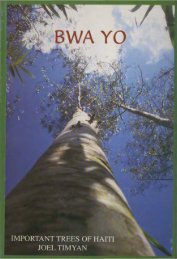Biodiversité - Société Audubon Haiti
Biodiversité - Société Audubon Haiti
Biodiversité - Société Audubon Haiti
Create successful ePaper yourself
Turn your PDF publications into a flip-book with our unique Google optimized e-Paper software.
62<br />
tyPes bIologIques<br />
Le fait que les arbustes et les herbacées prédominent est<br />
lié à l’environnement dans lequel les collectes ont été effectuées.<br />
Ce sont généralement des forêts secondaires,<br />
des végétations en première phase de régénération ou<br />
en régénération avancée. Cependant dans les forêts primaires<br />
moins atteintes par l’homme on peut observer, par<br />
exemple, un nombre élevé d’épiphytes situés surtout à une<br />
certaine hauteur parce qu’en quête de soleil. Ce même fait<br />
est observable pour les Fougères qui représentent 12,75 %<br />
des espèces collectées.<br />
endéMIsMes et rareté<br />
Six genres sont endémiques d’Hispaniola : Ekmaniopappus<br />
Borhidi, Elekmania B. Nordenstam, Hottea Urban, Manekia<br />
Trel., Nesampelos B. Nordenstam et Pedinopetalum Urban.<br />
Ekmaniopappus (Asteraceae) a été dissocié de Herodotia.<br />
Elekmania (Asteraceae) et Nesampelos (Asteraceae) sont de<br />
« création » récente Hottea (Myrtaceae) fait référence au<br />
Massif de La Hotte, d’où il fut décrit, bien que plus tard 6 espèces<br />
de ce genre aient été décrites comme appartenant<br />
au Massif de la Selle, au Bahoruco et à d’autres localités de<br />
la République Dominicaine.<br />
Manekia (Piperaceae) est monotypique et pousse seulement<br />
en Haïti.<br />
Pedinopetalum (Apiaceae) est aussi monotypique, mais<br />
pousse dans les deux territoires.<br />
Pour ce qu’il s’agit des espèces, 144 (40.79 %) sont endémiques<br />
d’Hispaniola. Ce pourcentage se révèlera peutêtre<br />
plus élevé lorsque qu’on aura terminé l’identification<br />
de tous les herbiers qui en sont restés à la détermination<br />
des genres. Beaucoup de ces espèces poussent uniquement<br />
en Haïti et quelques-unes exclusivement au Massif<br />
de la Hotte, comme : Eugenia tiburona, Eupatorium hotteanum,<br />
Nesampelos hotteana, Tabebuia conferta, Maytenus<br />
hotteana, Illicium hottensis, Manekia urbanii, Calyptranthes<br />
hotteana, Micropholis polita subsp. hotteana, Chimarrhis ekmanii,<br />
Rondeletia formonica et Cestrum hotteanum.<br />
Chimarrhis ekmanii (Rubiaceae) est une espèce arborescente<br />
très rare. Un seul individu a pu être trouvé au cours<br />
de cette expédition. Le spécimen fut identifié par le Professeur<br />
Atila Borhidi, (à qui revient la description de cette<br />
espèce décrite à partir d’un échantillon identifié comme<br />
un C. cymosa (Borhidi, communication personnelle, juin<br />
2006).<br />
taxons IdentIfIés jusqu’au nIveau<br />
de genre<br />
L’identification de beaucoup de taxons est très difficile vu<br />
que la plupart des types des espèces de la Hotte décrites se<br />
trouvent en Europe et aux USA. A ceci s’ajoute le fait que la<br />
flore de cette zone montagneuse possède un haut niveau<br />
d’endémisme local de distribution réduite, ou d’espèces<br />
peu connues. L’identification se fait en utilisant les clés de<br />
détermination et la littérature de différents auteurs.<br />
bIologIcal tyPes<br />
The species that we collected were predominately shrubs<br />
and herbaceous plants due to the types of environments<br />
in which we focused our collection efforts - generally early<br />
and advanced second-growth forests. However in the less<br />
impacted original forests we observed a high number of<br />
epiphytes, because they are on the highest tree branches<br />
where there is more sunlight. We saw the same pattern<br />
with ferns, which totaled 45 species, accounting for 12.75%<br />
of the total number of species collected.<br />
rare and endeMIc Plants:<br />
Hispaniola has six endemic genera: Ekmaniopappus Borhidi, Elekmania<br />
B. Nordenstam, Hottea Urban, Manekia Trel., Nesampelos<br />
B. Nordenstam y Pedinopetalum Urban. Ekmaniopappus (Asteraceae)<br />
was separated from Herodotia. Elekmania (Asteraceae) and<br />
Nesampelos (Asteraceae) were created recently. Hottea (Myrtaceae)<br />
refers to the Massif de La Hotte, where it was first described,<br />
although later six additional species in this genus were described<br />
from Massif de La Selle, Sierra de Bahoruco, and elsewhere. Manekia<br />
(Piperaceae) is monotipic and has been found only in <strong>Haiti</strong>.<br />
Pedinopetalum (Apiaceae) is also monotypic, and grows in both<br />
countries but is very rare.<br />
Of the species collected, 144 (40.79%) are endemic to Hispaniola.<br />
This percentage could rise when identification is concluded for<br />
plants thus far identified only to genera. Many of them grow only<br />
in <strong>Haiti</strong>, some exclusively on Massif de La Hotte, such as Eugenia<br />
tiburona, Eupatorium hotteanum, Nesampelos hotteana, Tabebuia<br />
conferta, Maytenus hotteana, Illicium hottensis, Manekia urbanii,<br />
Calyptranthes hotteana, Micropholis polita subsp. hotteana,<br />
Chimarrhis ekmanii, Rondeletia formonica y Cestrum hotteanum.<br />
Chimarrhis ekmanii (Rubiaceae) is a very rare tree species of which<br />
we encountered only one individual on the expedition. The specimen<br />
was identified by Dr. Atila Borhidi, who described the species,<br />
using a species identified as C. cymosa (Borhidi, pers. com., June<br />
2006) as a reference.<br />
taxa descrIbed to genus<br />
Identification of many taxa was difficult because type specimens<br />
for many species described from Massif de la Hotte are deposited<br />
outside Hispaniola, in Europe and the United States. Moreover,<br />
this region’s flora has an exceedingly high proportion of local<br />
endemism with restricted distribution, that is to say, little-known<br />
species. Many of the species collected during the expedition were<br />
not found in JSBD herbarium. We identified them using keys and<br />
literature of different various authors. Thirty-three taxa were identified<br />
only to genus.<br />
IMPortant fIndIngs<br />
Among the samples collected are a number of important plants.<br />
Some of them are rediscoveries of plants collected by E. L. Ekman,<br />
(and described by Urban, or by both of them), that were collected<br />
few additional times, or not at all. Of the species collected again<br />
during this expedition, 14 were not found in the JBSD herbarium:



